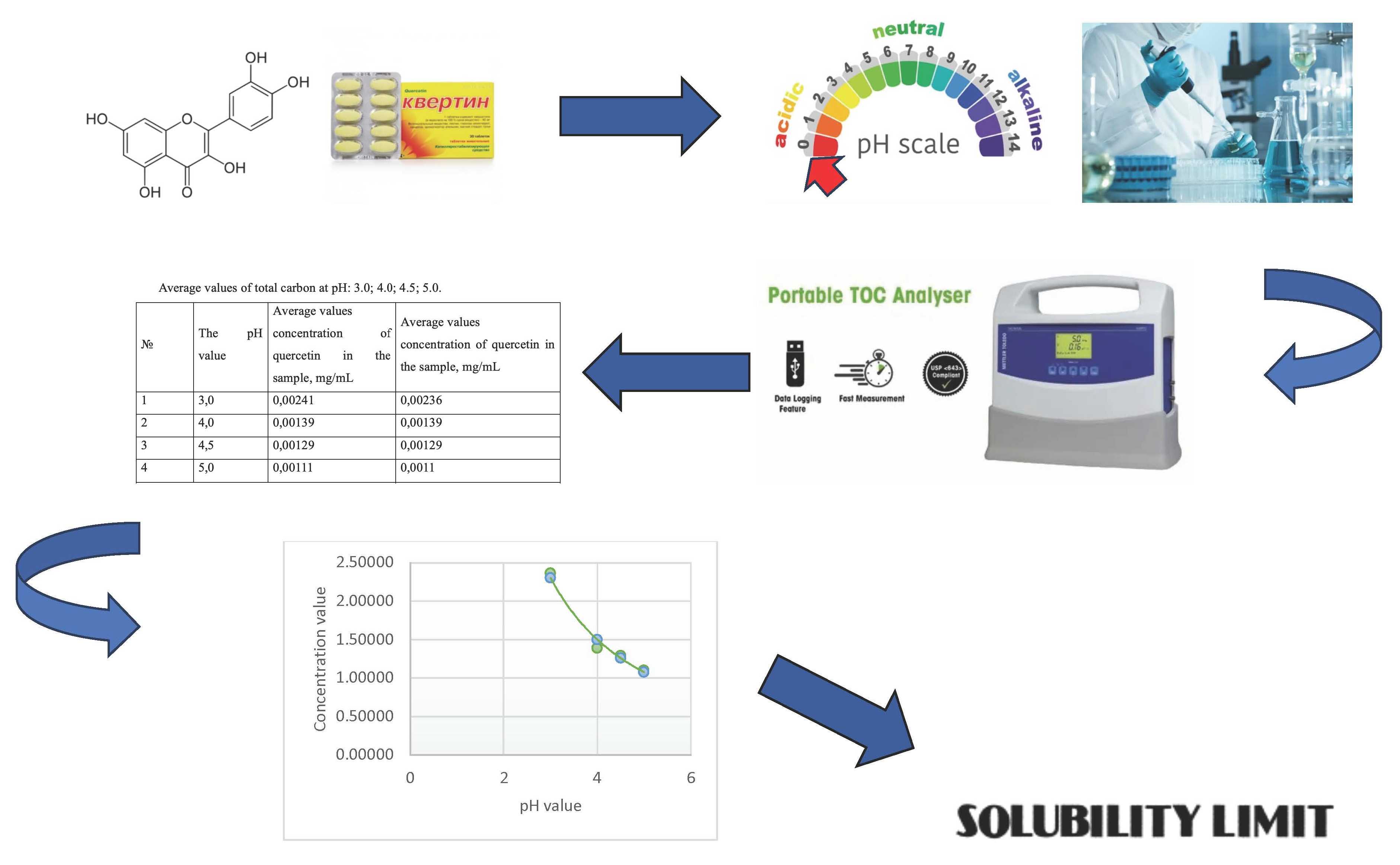Розробка нового рішення для визначення межі розчинності кверцетину та інших погано розчинних речовин у водних розчинах методом визначення загального органічного вуглецю
DOI:
https://doi.org/10.15587/2519-4852.2023.286639Ключові слова:
кверцетин, ідентифікація, кількісне визначення, загальний органічний вуглець, розробка методу, біоеквівалентність, біовейвер, розчинність, випробування на розчиненняАнотація
Мета. Враховуючи неповноту літературних даних про розчинність кверцетину та важливість цієї фізико-хімічної характеристики при дослідженні його біодоступності, існує потреба у розробці альтернативного методу точного кількісного визначення межі розчинності кверцетину.
Матеріали та способи. Концентрацію кверцетину в одержаних зразках розчинів кислоти визначали методом визначення загального органічного вуглецю безпосередньо. Для вимірювань використовували аналізатор загального органічного вуглецю 450 ТОС (METTLER TOLEDO) з діапазоном вимірюваних значень 0,05–1000 ppbC мкгС/л.
Результати. Встановлено точну межу розчинності кверцетину, як малорозчинної речовини. Попередньо вимірявши значення загального органічного вуглецю в приготовлених розчинах, ми отримали дані про концентрацію кверцетину в розчинах залежно від рН розчину.
Побудувавши графічну залежність виміряних значень концентрації речовини від значень рН досліджуваних розчинів отримуємо математичне рівняння залежності. Використовуючи отримане рівняння функції, можна апроксимувати значення концентрації речовини значення рН рівного 7,0. Ця величина і буде межею розчинності досліджуваної речовини для нейтральних середовищ.
Висновки. В результаті проведених досліджень було запропоновано новий метод кількісного визначення межі розчинності речовини, яка з точністю не перевищує 5,0 %. Метод підстав на вимірюванні концентрації загального вуглецю в кислих розчинах з різним значенням рН та подальшою апроксимацією отриманої залежності значення рН рівного 7,0
Посилання
- Pal, D. K., Verma, P. (2013). Flavonoids: A powerful and abundant source of antioxidants. International Journal of Pharmaceutical Sciences and Research, 5, 95–98.
- Tutelian, V. A., Lashneva, N. V. (2013). Biologically active substances of plant origin. Flavonols and flavones: Prevalence, dietary sources, and consumption. Voprosy Pitaniia, 82, 4–22.
- Lakhanpal, P., Rai, D. K. (2007). Quercetin: A Versatile Flavonoid. Internet Journal of Medical Update, 2 (2), 22–37. doi: https://doi.org/10.4314/ijmu.v2i2.39851
- Jung, J.-H., Kang, J.-I., Kim, H.-S. (2012). Effect of quercetin on impaired immune function in mice exposed to irradiation. Nutrition Research and Practice, 6 (4), 301–307. doi: https://doi.org/10.4162/nrp.2012.6.4.301
- Xiao, X., Shi, D., Liu, L., Wang, J., Xie, X., Kang, T., Deng, W. (2011). Quercetin Suppresses Cyclooxygenase-2 Expression and Angiogenesis through Inactivation of P300 Signaling. PLoS ONE, 6 (8), e22934. doi: https://doi.org/10.1371/journal.pone.0022934
- Liu, H., Zhang, L., Lu, S. (2012). Evaluation of Antioxidant and Immunity Activities of Quercetin in Isoproterenol-Treated Rats. Molecules, 17 (4), 4281–4291. doi: https://doi.org/10.3390/molecules17044281
- Lee, K. M., Hwang, M. K., Lee, D. E., Lee, K. W., Lee, H. J. (2010). Protective Effect of Quercetin against Arsenite-Induced COX-2 Expression by Targeting PI3K in Rat Liver Epithelial Cells. Journal of Agricultural and Food Chemistry, 58 (9), 5815–5820. doi: https://doi.org/10.1021/jf903698s
- Dong, Y., Wang, J., Feng, D., Qin, H., Wen, H., Yin, Z. et al. (2014). Protective Effect of Quercetin against Oxidative Stress and Brain Edema in an Experimental Rat Model of Subarachnoid Hemorrhage. International Journal of Medical Sciences, 11 (3), 282–290. doi: https://doi.org/10.7150/ijms.7634
- Agrawal, A. D. (2011). Pharmacological Activities of Flavonoids: A Review. International Journal of Pharmaceutical Sciences and Nanotechnology, 4 (2), 1394–1398. doi: https://doi.org/10.37285/ijpsn.2011.4.2.3
- Vauzour, D., Vafeiadou, K., Rodriguez-Mateos, A., Rendeiro, C., Spencer, J. P. E. (2008). The neuroprotective potential of flavonoids: a multiplicity of effects. Genes & Nutrition, 3 (3-4), 115–126. doi: https://doi.org/10.1007/s12263-008-0091-4
- Salvamani, S., Gunasekaran, B., Shaharuddin, N. A., Ahmad, S. A., Shukor, M. Y. (2014). Antiartherosclerotic Effects of Plant Flavonoids. BioMed Research International, 2014, 1–11. doi: https://doi.org/10.1155/2014/480258
- Denny Joseph, K. M., Muralidhara. (2013). Enhanced neuroprotective effect of fish oil in combination with quercetin against 3‐nitropropionic acid induced oxidative stress in rat brain. Progress in Neuro-Psychopharmacology and Biological Psychiatry, 40, 83–92. doi: https://doi.org/10.1016/j.pnpbp.2012.08.018
- Parasuraman, S., Maithili, K. S. (2014). Antioxidant and drug metabolism. Free Radicals and Antioxidants, 4 (1), 1–2. doi: https://doi.org/10.5530/fra.2014.1.1
- Procházková, D., Boušová, I., Wilhelmová, N. (2011). Antioxidant and prooxidant properties of flavonoids. Fitoterapia, 82 (4), 513–523. doi: https://doi.org/10.1016/j.fitote.2011.01.018
- Li, Y., Yao, J., Han, C., Yang, J., Chaudhry, M., Wang, S. et al. (2016). Quercetin, Inflammation and Immunity. Nutrients, 8 (3), 167. doi: https://doi.org/10.3390/nu8030167
- Salehi, B., Machin, L., Monzote, L., Sharifi-Rad, J., Ezzat, S. M., Salem, M. A. et al. (2020). Therapeutic Potential of Quercetin: New Insights and Perspectives for Human Health. ACS Omega, 5 (20), 11849–11872. doi: https://doi.org/10.1021/acsomega.0c01818
- Nastanova z klinichnykh doslidzhen «Likarski zasoby. Doslidzhennia biodostupnosti ta bioekvivalentnosti» (Nastanova 42–7.1:2005) (2005). Kyiv: Ministerstvo okhorony zdorov’ia Ukrainy.
- Khanina, N., Georgiyants, V., Khanin, V. (2023). Development of a method for the quantitative determination of the solubility limits of poorly soluble in water substances on the example of quercetin. ScienceRise: Pharmaceutical Science, 3 (43), 58–66. doi: https://doi.org/10.15587/2519-4852.2023.283293
- PubChem. Available at: https://pubchem.ncbi.nlm.nih.gov/compound/Quercetin
- Derzhavna Farmakopeia Ukrainy. Vol. 1. Kharkiv: Derzhavne pidpryiemstvo «Ukrainskyi naukovyi farmakopeinyi tsentr yakosti likarskykh zasobiv», 1, 1128.
- Epshtein, N. A. (2019). Validation of Analytical Procedures: Graphic and Calculated Criteria for Assessment of Methods Linearity in Practice. Drug Development & Registration, 8 (2), 122–130. doi: https://doi.org/10.33380/2305-2066-2019-8-2-122-130

##submission.downloads##
Опубліковано
Як цитувати
Номер
Розділ
Ліцензія
Авторське право (c) 2023 Nataliia Khanina, Victoriya Georgiyants, Vadim Khanin

Ця робота ліцензується відповідно до Creative Commons Attribution 4.0 International License.
Наше видання використовує положення про авторські права Creative Commons CC BY для журналів відкритого доступу.








